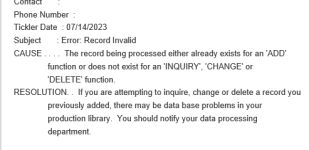FrankCLT
Well Known Member
Good morning all,
We are integrating with a 3rd party vendor that will allow suppliers to change Quantities, maybe price and possibly cancel some lines on PO's and send that data back to us. Regardless of what data is being sent to and from the 3rd party, I would like to simulate the actions as if a purchasing agent was manually making the changes. For example, all the actions that take place when a quantity or price is changed, or line is cancelled, or a row is exited with a change.
Would I be looking at something like the EDI UBE's and tables related for Purchasing?
This would not be EDI, just want to leverage anything that JDE has that I can use.
Thank you,
FrankCLT
We are integrating with a 3rd party vendor that will allow suppliers to change Quantities, maybe price and possibly cancel some lines on PO's and send that data back to us. Regardless of what data is being sent to and from the 3rd party, I would like to simulate the actions as if a purchasing agent was manually making the changes. For example, all the actions that take place when a quantity or price is changed, or line is cancelled, or a row is exited with a change.
Would I be looking at something like the EDI UBE's and tables related for Purchasing?
This would not be EDI, just want to leverage anything that JDE has that I can use.
Thank you,
FrankCLT






